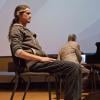
USC professor Josh Kun isn’t curating Quantum Vibrations — a free four-part music series exploring the intersection of art and science — in a vacuum. The concerts are part of PST ART, the landmark Southern California arts event that in previous years was dubbed Pacific Standard Time.
Presented by the Popular Music Project at USC Annenberg’s Norman Lear Center, Quantum Vibrations launched on Oct. 4 and continues with three more performances. The next installment in the series takes places Oct. 17 at the Getty Center and features the work of multidisciplinary artist Tania Candiani. A family-friendly presentation follows on Nov. 9 at the La Brea Tar Pits, with two local musical groups, Quetzal and La Familia Gutiérrez, joining forces. Flutist Claire Chase and guests close the series on Nov. 17 at the Ebell of Los Angeles.
Kun, who was named USC’s vice provost for the arts last year, said the series’ title “was obviously inspired by quantum physics and quantum theory. But it was also inspired by the work of [composer] Pauline Oliveros — her ideas about quantum listening — and I used that as an inspiration for the uniting thread of our four concerts.”

Kun, a 2016 MacArthur Fellow, doesn’t play an instrument himself but has past experience hosting a radio show. He said the criteria for choosing musicians for Quantum Vibrations were “wide open. I pitched the Getty Center, and the way it works is [that] you create a proposal. They review it, give you feedback, approve it, and offer a grant. I proposed these four events because I was looking for different approaches to music and science.
“Bodies of thought and artistic practice have been linked since the beginning of music and science,” Kun added. “I was looking at how contemporary artists were approaching that intersection. I was also thinking about issues around the diversity of musical genres. I wanted to make sure [these concerts] represented different approaches, and I ended up with this incredible group.”
“Quantum Preludes,” on Oct. 17, features the Mexico City-based Candiani, whose work has become increasingly sonorous and loud since 2002. She’s expected to be joined by, among others, experimental musician and sound artist Rogelio Sosa. The event marks the first time that a selection of Candiani’s films will be accompanied by live musicians.
Kun explained, “Tania made a series of films, all of which use music in different ways. I thought it would be a fun experiment to screen those films but with live music. An ensemble of vocalists and musicians will be live-scoring three films during one night.”
Fun is the point of “A Song on the Meadow Is a Song in the City,” the Nov. 9 presentation at the La Brea Tar Pits. “The Getty’s doing an art and science family festival there all day,” said Kun. “We thought it would be a good setting for this concert. [These two musical families are] going to do interpretations of classical Mexican songs and songs about the natural landscape — insects, animals, reptiles, iguanas, and mountain rivers.”
As for the final program with Chase and friends, “A Day of Quantum Listening,” Kun noted that the flutist “has done a version of this at Carnegie Hall.” The event intends to blur the lines between listening, learning, and performing — in effect celebrating Oliveros’s groundbreaking sonic investigations into the physical sciences and the science of hearing.

When asked how, in a nutshell, art and science collide, Kun acknowledged that it “happens every day. I’m personally interested in the way musicians think about science and how much they consider scientific questions through physics, life sciences, or through environmentalists or ecological approaches.
“What I love about PST,” Kun continued, “is that the themes push me to think in directions I might not normally think.”
Kun mentioned the impact of this line of investigation in the medical world. “The role music is currently playing in Alzheimer’s research — and music and dance in [treating] Parkinson’s patients — is such a wide one. The more I started thinking about it, these four concerts are just little attempts to address that.
“Being moved by music is itself a scientific activity,” Kun added. “Our brains are being activated in different ways than our bodies are being activated. If you go see an opera, you’re a different person after the opera. I would love people to be moved and to think about why they’re being moved. If they’re thinking about bigger questions, that’s a bonus.”




